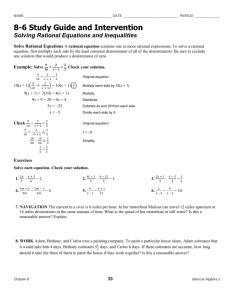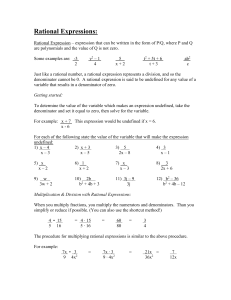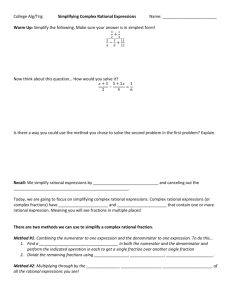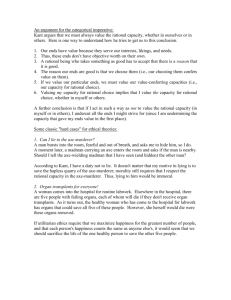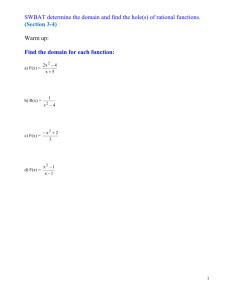On the cycle length of the Collatz sequence
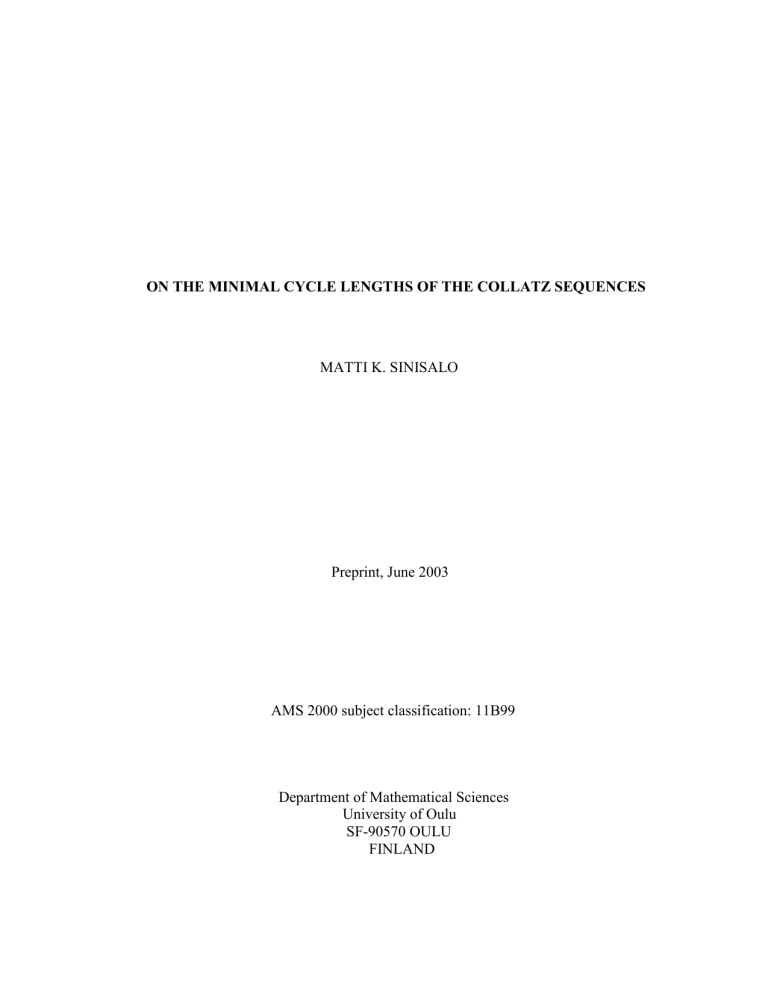
ON THE MINIMAL CYCLE LENGTHS OF THE COLLATZ SEQUENCES
MATTI K. SINISALO
Preprint, June 2003
AMS 2000 subject classification: 11B99
Department of Mathematical Sciences
University of Oulu
SF-90570 OULU
FINLAND
ON THE MINIMAL CYCLE LENGTHS OF THE COLLATZ SEQUENCES
Matti K. Sinisalo
1§. Introduction
Let x be an integer. Let the function C(x) be equal to 3x+1 if x is odd and equal to x/2 if x is even. Iterating this function from the initial value 1 we get a trivial cycle {1,4,2} . The 3x+1 conjecture asserts that starting from any positive integer a
1
the repeated iteration of C(x) eventually produces the integer 1 , after which the iterates will alternate between the integers of the trivial cycle. This assertion posed by L. Collatz in 1937 has turned out to be very hard to prove. It has been widely studied in different places all over the world. Besides the Collatz problem, it has been called by many other names, like 3x+1 mapping, Hasse's algorithm,
Kakutani's problem, Syracuse algorithm or problem, Thwaites conjecture, and Ulam's problem.
In spite of massive try and effort, the Collatz conjecture is still unproven.
Number a
1
is said to converge if C h
(a
1
) = 1 for some positive integer h . In order to prove that all positive initial values a
1
up to some number R converge, it is sufficient to check that for all
2 < a
1
≤ R there exist some integer h such that C h
(a
1
) < a
1
. If Collatz conjecture is not true for some integer a
1
we have two possibilities: Either 1) the sequence starting from a
1
turns to infinity or 2) the sequence enters to cycle other than the trivial one {1, 2, 4} .
Until now all numbers up to 204 * 2 50 (
2.29 * 10 17 ) have been checked for convergence.
All numbers up to this bound have been verified to converge [7] . In this paper we are going to study possible nontrivial cycles in Collatz sequences. If there exists a nontrivial cycle we know that every integer belonging to this cycle must be larger than the bound referred to above.
Lagarias showed in 1985 that there are no nontrivial cycles with length less than 275,000 .
It should be noted that Lagarias used (3x+1)/2 operation instead of 3x+1 operation. This gives shorter cycle lengths. We will return to this later.
Our aim in this paper is to show that there are no nontrivial cycles with length less than
1,000,000,000 . We also show that only certain discrete values are possible for the cycle lengths of the Collatz sequence.
1
2§. Basic inequalities
LEMMA 1: Let us suppose that there exists an untrivial cycle of length m in some Collatz sequence with positive initial value. Let k be the number of 3x+1 operations and n the number of x/2 operations in the cycle. Hence k+n=m. Suppose that the smallest number in the sequence is greater than some (with a computer reachable bound) number R. Then ln (3)/ ln
(2) < n/k ≤ ln (3+1/R)/ ln (2).
PROOF: Let c
1
, c
2
,...,c m
be the rational integer numbers of the cycle i.e. c i+1
= C(c i
) for all i=1,2,...,m-1 and c
1
= C(c m
) . Without restricting the generality we can assume c
1
to be the smallest one of them.
Let r
1
, r
2
,... r k
be the ratios of succeeding integers in sequence when 3x+1 operation has been used. Now r
1 r
2
...r
k
= 2 n
.
On the other hand 3 < r i
≤ (3c
1
+1)/c
1
= 3+1/c
1
for all i=1,...,k .
Hence 3 k
< 2 n
= r
1 r
2
...r
k
≤ (3+1/c
1
) k
, and therefore k ln (3) < n ln
(2) ≤ k ln (3+1/c
1
) .
Consequently ln( 3 ) ln( 2 )
< n
≤ k ln( 3
ln( 2 )
1 c
1
)
.
If
R ≤ c
1
we have ln( 3 ) ln( 2 ) n
< k
≤ ln( 3
ln( 2 )
1
R
)
.
Our problem now is to find the rational number n/k such that these inequalities are satisfied and n+k is as small as possible.
We will show that this follows if the denominator k is the least possible. For this we need some results concerning rational approximations.
3§. Results concerning Farey sequences and rational approximations
By the Farey sequence F m
of order m we mean the positive fractional numbers, whose denominators do not exceed m , arranged in ascending order of magnitude.
2
Let us take some notations and terms in use. If x is a real number, then
x
is the largest integer that is less than or equal to x . Subsequently we define residual function Mod
:Z×Z +
→ Z by setting m =
m/n
n + Mod (m,n) for all m
Z , n
Z
+
.
If m and n are rational integers, n > 0 and gcd (m,n) = 1 , then using (extended) Euclidean algorithm we can find such rational integers a and b , that am+bn = 1 . Then am ≡ 1
(mod n ).
Congruence equation mx ≡ 1
(mod n ) can hence be effectively solved. This solution is called the modular inverse of the number m modulo n .
A rational number is in reduced form if the greatest common divisor of the numerator and the denominator is 1 .
When processing with Farey sequences the following lemma is essential, see [4].
LEMMA 2: Let p , q and m be positive integers, q ≤ m and gcd (p,q) = 1. Let r be a modular inverse of p modulo q and
q' =
m
r q
q – r = m - Mod (m+r,q) and p' = pq '
1 q
.
Then 0 < q' ≤ m, gcd (p',q')=1 and the number p'/q' is the smallest rational number greater than p/q and with the denominator ≤ m.
PROOF: 1) Clearly q' is a rational integer. Consequently pq'+1 = p
(m+r)/q
q-pr+1 ≡ 0
(mod q ). Hence p' is also a rational integer.
2) Because of p'q - pq' = 1 we have gcd (p',q') = 1 . Hence number p'/q' is in reduced form.
3) Multiplying the inequalities
0 ≤ m
r q
-
m
r q
≤ q
1 q by the number q and adding number r we get r ≤ m+r-q' ≤ q-1+r , and consequently m+1-q ≤ q' ≤ m
.
4) We show that between the rational numbers p/q and p'/q' there cannot exist any rational number having denominator
≤ m
. Let us suppose that p/q < s/t < p'/q', 0 < t ≤ m
. Then sq - pt ≥ 1, p't-sq' ≥ 1
and consequently
1 = p'q-pq' = qq' (
= qq'( p ' t
tq ' sq '
+ sq
p ' q ' tq
- pt
) p q
) = qq'((
qq'(
1 tq '
+ p ' q '
1 tq
- t s
) = s
) + ( t q
q ' t
- p q
> m t
))
≥ 1.
3
This is a contradiction.
Hence p/q and p'/q' are successive rational numbers in Farey sequence F m
.
The essential parts of the proof can be found in the book of Hardy and Wright 1938 [3]. The preceding computationally useful form is not given, anyway.
The following lemma can be proved analogously to Lemma 2.
LEMMA 3:
Let p,q,m be positive rational integers, q ≤ m and gcd (p,q)=1. Let r be a modular inverse of p modulo q and
q'' =
m
r q
q+r = m- Mod (m-r,q) and p'' = pq ''
1 q
.
Then 0 < q'' < m, gcd (q'',p'')=1 and the number p''/q'' is the greatest rational number smaller than p/q and with the denominator ≤ m.
The preceeding lemmas give explicit expressions to the immediately following and to the immediately preceding numbers of a given number in some Farey sequence. The method is based on the modular arithmetics and the Euclidean algorithm. This method works (by
Mathematica experiments) quite well even with the numbers with 1000-10000 decimal digits.
The Farey sequences have applications in a very wide area of mathematics. However, our computationally important explicit results have not been presented, as far as we know, in the litterature of the elementary number theory, computational number theory or the theory of mathematical algorithms.
We can now write short Mathematica programs for using lemmas 2 and 3 effectively.
NextFarey[s_, m_] :=
First[{p = Numerator[s];
q = Denominator[s];
r = First[Part[ExtendedGCD[p, q], 2]];
q2 = Quotient[m + r, q]*q - r;
p2 = (p*q2 + 1)/q;
p2/q2}]
PreviousFarey[s_, m_] :=
First[{p = Numerator[s];
q = Denominator[s];
r = First[Part[ExtendedGCD[p, q], 2]];
q2 = Quotient[m - r, q]*q + r;
p2 = (p*q2 - 1)/q;
p2/q2}]
NextBestUpper[s_] :=
4
NextFarey[s, Denominator[s]]
NextBestLower[s_] :=
PreviousFarey[s, Denominator[s]]
In the proof of Lemma 2 we have also proved the following Lemma.
LEMMA 4: (Farey-Cauchy theorem) If p/q and p'/q', where 0 < q, 0 < q' and gcd (p,q) = gcd (p',q') = 1, are any successive rational numbers in Farey sequence F m
, then p'q - pq' = 1.
Using Farey-Cauchy theorem we can prove the following simple lemma.
LEMMA 5:
Let 0 ≤ β
< α < n/k ≤ β and let k be the least possible positive denominator value for which these inequalities are satisfied. Then
a) k > 1, n/k is unique and
b) if c/d, where d > 1 is any other rational number for which α < c/d ≤ β then n+k ≤ c+d.
PROOF: a) It’s clear that k > 1 . Trivially k has a unique value. If n is not unique, then either
1)
α < j/k < n/k ≤ β
or 2)
α < n/k < j/k ≤ β for some positive integer j for which gcd (j,k) =
1.
In case 1) j/k and n/k are successive rational numbers in order k Farey sequence. By the
Farey-Cauchy theorem 1 = kn - kj = k(n-j)
k . This is a contradiction.
In case 2) n/k and j/k are successive rational numbers in order k Farey sequence. By the
Farey-Cauchy theorem 1 = jk – nk = (j-n)k
k . This is a contradiction. b) By a) we have
α ≥ (n-1)/k
( n is unique) and by the definition of k , d ≥ k
.
Hence c d
> α
c > αd ≥ n
1
d
ck > (n-1)d
ck ≥ (n-1)d + 1
c ≥ k
( n
1 ) d k
1
c+d ≥
( n
1 ) d k
1
+ d ≥
( n
1 ) k k
1
+ k = n - 1 +
c + d ≥ n + k .
1
+ k = n+ k - 1 + k
1
> n + k - 1 k
5
4§. Back to the Collatz problem
We are now ready to prove our main results concerning the cycle lengths of the Collatz sequences.
THEOREM 1: Let the Collatz conjecture be verified up to some bound R > 1. Let n/k be the rational number with least possible denominator k such that ln (3)/ ln
(2) < n/k ≤ ln (3+1/R)/ ln (2). Then the least possible cycle length for nontrivial cycle is n+k.
PROOF: Let c be the number of x/2 operations and d the number of 3x+1 operations in the shortest nontrivial cycle. By lemma 1 we have ln (3)/ ln
(2) < c/d ≤ ln (3+1/R)/ ln (2) . Let us denote α = ln (3)/ ln (2) and β = ln (3+1/R)/ ln (2). Now
1 =
ln( 3 ) ln( 2 )
ln( 3
ln( 2 )
1
R
)
=
β ln( 3
ln( 2 )
1
R
) ln( 4 )
< ln( 2 )
= 2.
Necessarily
β
= 1.
Now 0 < 1 =
β
< ln(3)/ln(2) =
α < n/k < β.
By lemma 5 integers n and k are unique and k > 1 . Furthermore we have c+d ≥ n+k
. But c
+ d equals to the length of the cycle.
THEOREM 2: The length of any nontrivial cycle in Collatz sequence is at least
1,027,712,276 .
PROOF: The 20. convergent of ln (3)/ ln (2) is the first one of them that satisfies our inequalities when R = 204*2
50
. It's value is 630,138,897/397,573,379 . The closest neighbours of it in order 397,573,379 Farey sequence are 357,638,239/225,644,606 and
272,500,658/171,928,773 . They don't belong to our interval. So our convergent has the least possible denominator in our interval and the sum of its numerator and denominator is the least possible length of a nontrivial cycle in Collatz sequence. Now we get m = n + k = 630,138,897
+ 397,573,379 = 1,027,712,276 .
NOTE 1.
Some researchers use (3x+1)/2 operation instead of 3x+1 operation that we have used in the definition of the Collatz sequence. In this case the numbers 3x+1 and following
(3x+1)/2 are not considered as different iterates of the cycle. This gives shorter cycle lengths.
It is easy to see that instead of the sum of the numerator and the denominator the cycle length is given by just numerator of our rational approximation. When the operations x/2 and
(3x+1)/2 are used the minimal cycle length is hence still at least 630,138,897 .
NOTE 2 . Tomas Oliveira e Silva has checked the Collatz sequences to converge with all initial values up to 3*2
53
(
2.702*10
16
) [8] . As far as we know, his result is the best one published
6
in international refereed mathematical journals. It is easy to see, that this result gives exactly the same minimal cycle length as we have reached before.
The following table gives best rational upper approximations for ln (3)/ ln (2).
If an approximation is a continued fraction convergent its order number is given in the second column. The third column gives the sum of the numerator and the denominator of the rational approximation. This is the length of representing cycle of Collatz sequence. The last column gives the bound to be reached by computer calculations or by theoretical studies to eliminate the possibility of cycle of this size to exist.
Rational approximation n/k
683,381,996,816,440 / 431,166,034,846,567
600,251,839,738,223 / 378,716,745,326,851
517,121,682,660,006 / 326,267,455,807,135
433,991,525,581,789 / 273,818,166,287,419
350,861,368,503,572 / 221,368,876,767,703
267,731,211,425,355 / 168,919,587,247,987
184,601,054,347,138 / 116,470,297,728,271
101,470,897,268,921 / 64,021,008,208,555
18,340,740,190,704 / 11,571,718,688,839
8,573,543,875,303 / 5,409,303,924,479
7,379,891,435,205 / 4,656,193,084,598
6,186,238,995,107 / 3,903,082,244,717
4,992,586,555,009 / 3,149,971,404,836
3,798,934,114,911 / 2,396,860,564,955
2,605,281,674,813 / 1,643,749,725,074
1,411,629,234,715 / 890,638,885,193
217,976,794,617 / 137,528,045,312
114,208,327,604 / 72,057,431,991
10,439,860,591 / 6,586,818,670
630,138,897 / 397,573,379
272,500,658 / 171,928,773
187,363,077 / 118,212,940
102,225,496 / 64,497,107
17,087,915 / 10,781,274
301,994 / 190,537
125,743 / 79,335
75,235 / 47,468
24,727 / 15,601
23,673 / 14,936
22,619 / 14,271
21,565 / 13,606
20,511 / 12,941
Convergent number
1,114,548,031,663,007
978,968,585,065,074
843,389,138,467,141
707,809,691,869,208
572,230,245,271,275
436,650,798,673,342
301,071,352,075,409
165,491,905,477,476
29,912,458,879,543
13,982,847,799,782
12,036,084,519,803
10,089,321,239,824
8,142,557,959,845
6,195,794,679,866
4,249,031,399,887
2,302,268,119,908
355,504,839,929
186,265,759,595
17,026,679,261
1,027,712,276
444,429,431
305,576,017
166,722,603
27,869,189
492,531
205,078
122,703
40,328
38,609
36,890
35,171
33,452
-
-
16.
14.
12.
-
10.
-
-
-
-
-
-
24.
-
22.
20.
18.
-
-
-
-
-
-
28.
26.
30.
-
-
-
-
-
Cycle length m = n + k
Computational bound
R = 1/(2 n/k -3)
1.07756 x 10 29
4.54238 x 10
28
2.57441 x 10 28
1.60979 x 10
28
1.03707 x 10 28
6.57741 x 10 27
3.88004 x 10
27
1.86358 x 10 27
2.99088 x 10
26
2.73493 x 10 25
8.39455 x 10
24
4.28181 x 10 24
2.48336 x 10
24
1.47471 x 10 24
8.29256 x 10 23
3.80765 x 10 23
5.10126 x 10 22
4.35849 x 10
21
2.16891 x 10 20
1.25208 x 10
18
3.20306 x 10 16
7.48875 x 10
15
2.46143 x 10 15
2.94402 x 10
14
9.84573 x 10
11
7.21611 x 10 9
1.44769 x 10
9
2.85818 x 10 8
8.04976 x 10
7
4.50889 x 10 7
3.04065 x 10
7
2.23726 x 10 7
7
4,701 / 2,966
3,647 / 2,301
2,593 / 1,636
1,539 / 971
485 / 306
401 / 253
317 / 200
233 / 147
149 / 94
65 / 41
46 / 29
27 / 17
8 / 5
5 / 3
2
19,457 / 12,276
18,403 / 11,611
17,349 / 10,946
16,295 / 10,281
15,241 / 9,616
14,187 / 8,951
13,133 / 8,286
12,079 / 7,621
11,025 / 6,956
9,971 / 6,291
8,917 / 5,626
7,863 / 4,961
6,809 / 4,296
5,755 / 3,631
44
13
8
3
380
243
106
75
7,667
5,948
4,229
2,510
791
654
517
19,700
17,981
16,262
14,543
12,824
11,105
9,386
31,733
30,014
28,295
26,576
24,857
23,138
21,419
-
4.
-
2.
-
-
6.
-
-
8.
-
-
-
-
-
-
-
-
-
-
-
-
-
-
-
-
-
-
-
27,114
12,825
6,725
3,343
1,193
387
147
32
6
1
1.73049 x 10 7
1.38168 x 10
7
1.12692 x 10 7
9.32702 x 10
6
7.79732 x 10 6
6.56133 x 10
6
5.54185 x 10 6
4.68659 x 10
6
3.95881 x 10 6
3.33200 x 10 6
2.78651 x 10
6
2.30747 x 10 6
1.88344 x 10
6
1.50545 x 10 6
1.16640 x 10
6
860,564
583,288
330,750
99,781
Table 1: The best rational upper approximations to ln (3)/ ln (2) , the corresponding cycle length in 3x+1 problem and the bound for systematic computer verifications to eliminate this cycle length from the table.
We can see from the table that in order to eliminate the possible existence of a cycle of length
1,027,712,276 we should verify that all integers up to 1.25208 x 10
18
converge. The next possible value for cycle length would then be 17,026,679,261 .
The table has been constructed in following way. First of all we computed first 30 terms in the continued fraction expansion for ln (3)/ ln (2) . The result is
[1; 1, 1, 2 ,2, 3, 1, 5, 2, 23, 2, 23, 2 2, 1, 1, 55, 1, 4, 3, 1, 1, 15, 1, 9, 2, 5, 7, 1, 1 ,4, 8].
From this expansion we get the 30. convergent for ln (3)/ ln (2) , which is
683,381,996,816,440/431,166,034,846,567.
Starting from this we get the next best upper approximations one by one using our Mathematica program NextBestUpper . All
8
convergents having even order number between 10 and 30 appear in our table. That's natural because from the theory of continued fraction expansions it is generally known that the convergents are best rational approximations for the studied real number. Anyway, as we see from our table, they are not the only best approximations to a real number. For computing the last column value we have set equality on upper bound n/k= ln (3+1/R)/ ln (2). Solving R we get
R = 1/(2 n/k -3) . Because n/k is the best possible rational approximation for ln (3)/ ln (2) we have used at least 100 digit precision in the computations of these bounds.
We have studied the Collatz problem for positive initial values. If we want to do the same for negative values also, we can define another integer sequence by defining b i
=-a i
for all positive integer values of i . It is now easy to see, that for all i we have b i+1
=3b i
-1 if b i+1
is odd and b i+1
=b i
/2 if b i+1 is even. If b
1
is positive integer, all the iterates b i
have positive integer values.
It is easy to see that our 3x-1 sequences have trivial cycles {1, 2} , {5, 14, 7, 20, 10} and {17, 50,
25, 74, 37, 110, 55, 164, 82, 41, 122, 61, 182, 91, 272, 136, 68, 34, 17} .
Analogously to Lemma 1 we can prove the following result for 3x-1 problem.
LEMMA 6: Let us suppose that there exists an nontrivial cycle of length m in some 3x-1 sequence (with positive initial value). Let k be the number of 3x-1 operations and n the number of x/2 operations in the cycle (Hence k+n=m). Suppose that the smallest number in sequence is greater than some (with a computer reachable bound) number R. Then ln( 3
ln( 2 )
1
R
)
≤ n
< k ln( 3 ) ln( 2 )
.
The following table gives best rational lower approximations for ln (3)/ ln (2) . As in table 1, if approximation is a continued fraction convergent its order number is given in the second column. The third column gives the sum of the numerator and denominator of the rational approximation. This is the length of representing cycle of Collatz sequence. The last column gives the bound to be reached by computer calculations or by theoretical studies to eliminate the possibility of cycle of this size to exist.
Rational approximation n/k
83,130,157,078,217 / 52,449,289,519,716
64,789,416,887,513 / 40,877,570,830,877
46,448,676,696,809 / 29,305,852,142,038
28,107,936,506,105 / 17,734,133,453,199
9,767,196,315,401 / 6,162,414,764,360
1,193,652,440,098 / 753,110,839,881
975,675,645,481 / 615,582,794,569
757,698,850,864 / 478,054,749,257
Convergent number
29.
-
-
-
27.
25.
-
-
Cycle length m = n + k
135,579,446,597,933
105,666,987,718,390
75,754,528,838,847
45,842,069,959,304
15,929,611,079,761
1,946,763,279,979
1,591,258,440,050
1,235,753,600,121
Computational bound
R = 1/(3-2 n/k )
1.20960 x 10 28
9.50064 x 10
26
3.58630 x 10 26
1.47286 x 10
26
3.87339 x 10 25
2.11025 x 10
24
2.01643 x 10 23
8.31572 x 10
22
9
539,722,056,247 / 340,526,703,945
321,745,261,630 / 202,998,658,633
103,768,467,013 / 65,470,613,321
93,328,606,422 / 5,888,379,4651
82,888,745,831 / 52,296,975,981
72,448,885,240 / 45,710,157,311
62,009,024,649 / 39,123,338,641
51,569,164,058 / 32,536,519,971
41,129,303,467 / 25,949,701,301
30,689,442,876 / 19,362,882,631
20,249,582,285 / 12,776,063,961
9,809,721,694 / 6,189,245,291
9,179,582,797 / 5,791,671,912
8,549,443,900 / 5,394,098,533
7,919,305,003 / 4,996,525,154
7,289,166,106 / 4,598,951,775
6,659,027,209 / 4,201,378,396
6,028,888,312 / 3,803,805,017
5,398,749,415 / 3,406,231,638
4,768,610,518 / 3,008,658,259
4,138,471,621 / 2,611,084,880
3,508,332,724 / 2,213,511,501
2,878,193,827 / 1,815,938,122
2,248,054,930 / 1,418,364,743
1,617,916,033 / 1,020,791,364
987,777,136 / 623,217,985
357,638,239 / 225,644,606
85,137,581 / 53,715,833
68,049,666 / 42,934,559
50,961,751 / 32,153,285
33,873,836 / 21,372,011
16,785,921 / 10,590,737
16,483,927 / 10,400,200
16,181,933 / 10,209,663
15,879,939 / 10,019,126
15,577,945 / 9,828,589
15,275,951 / 9,638,052
14,973,957 / 9,447,515
14,671,963 / 9,256,978
14,369,969 / 9,066,441
14,067,975 / 8,875,904
13,765,981 / 8,685,367
13,463,987 / 8,494,830
13,161,993 / 8,304,293
12,859,999 / 8,113,756
12,558,005 / 7,923,219
12,256,011 / 7,732,682
10
-
19.
17.
-
-
-
-
-
-
-
-
-
-
-
-
-
-
21.
-
-
-
-
-
-
-
-
-
-
-
23.
-
-
-
-
-
-
-
-
-
-
-
-
-
-
15.
-
-
12,915,830,157
11,888,117,881
10,860,405,605
9,832,693,329
8,804,981,053
7,777,268,777
6,749,556,501
5,721,844,225
4,694,131,949
3,666,419,673
2,638,707,397
1,610,995,121
583,282,845
138,853,414
110,984,225
83,115,036
880,248,760,192
524,743,920,263
169,239,080,334
152,212,401,073
135,185,721,812
118,159,042,551
101,132,363,290
84,105,684,029
67,079,004,768
50,052,325,507
33,025,646,246
15,998,966,985
14,971,254,709
13,943,542,433
55,245,847
27,376,658
26,884,127
26,391,596
25,899,065
25,406,534
24,914,003
24,421,472
23,928,941
23,436,410
22,943,879
22,451,348
21,958,817
21,466,286
20,973,755
20,481,224
19,988,693
5.15618 x 10 15
9.12750 x 10 14
3.84335 x 10 14
1.77685 x 10
14
6.74993 x 10 13
2.96789 x 10
13
1.87697 x 10 13
1.35859 x 10
13
1.05572 x 10 13
8.57086 x 10 12
7.16787 x 10
12
6.12412 x 10 12
5.31731 x 10
12
4.67497 x 10 12
4.15146 x 10
12
3.71660 x 10 12
3.34963 x 10
12
3.03580 x 10 12
2.76435 x 10
12
2.52724 x 10 12
4.03240 x 10 22
1.82213 x 10
22
4.73167 x 10 21
1.33203 x 10
21
7.01263 x 10 20
4.35564 x 10
20
2.89130 x 10 20
1.96378 x 10
20
1.32361 x 10 20
8.55167 x 10 19
4.97527 x 10
19
2.15533 x 10 19
9.57790 x 10
18
5.84903 x 10 18
4.03027 x 10
18
2.95319 x 10 18
2.24096 x 10 18
1.73505 x 10
18
1.35714 x 10 18
1.06411 x 10
18
8.30251 x 10 17
6.39288 x 10
17
4.80408 x 10 17
3.46152 x 10
17
2.31207 x 10 17
1.31687 x 10
17
4.46811 x 10 16
11,954,017 / 7,542,145
11,652,023 / 7,351,608
11,350,029 / 7,161,071
11,048,035 / 6,970,534
10746,041 / 6,779,997
10,444047 / 6,589,460
10,142,053 / 6,398,923
9,840,059 / 6,208,386
9,538,065 / 6,017,849
9,236,071 / 5,827,312
8,934,077 / 5,636,775
8,632,083 / 5,446,238
8,330,089 / 5,255,701
8,028,095 / 5,065,164
7,726,101 / 4,874,627
7,424,107 / 4,684,090
7,122,113 / 4,493,553
6,820,119 / 4,303,016
6,518,125 / 4,112,479
6,216,131 / 3,921,942
5,914,137 / 3,731,405
5,612,143 / 3,540,868
5,310,149 / 3,350,331
5,008,155 / 3,159,794
4,706,161 / 2,969,257
4,404,167 / 2,778,720
4,102,173 / 2,588,183
3,800,179 / 2,397,646
3,498,185 / 2,207,109
3,196,191 / 2,016,572
2,894,197 / 1,826,035
2,592,203 / 1,635,498
2,290,209 / 1,444,961
1,988,215 / 1,254,424
1,686,221 / 1,063,887
1,384,227 / 873,350
1,082,233 / 682,813
780,239 / 492,276
478,245 / 301,739
176,251 / 111,202
50,508 / 31,867
25,781 / 16,266
1,054 / 665
569 / 359
84 / 53
19 / 12
11 / 7
11
-
-
-
-
-
-
-
-
-
-
-
-
-
-
-
-
-
-
-
-
-
-
-
-
-
-
-
-
-
-
-
9.
-
7.
-
-
13.
11.
5.
-
-
-
-
-
-
-
-
12,600,728
12,108,197
11,615,666
11,123,135
10,630,604
10,138,073
9,645,542
9,153,011
8,660,480
8,167,949
7,675,418
7,182,887
6,690,356
6,197,825
5,705,294
5,212,763
19,496,162
19,003,631
18,511,100
18,018,569
17,526,038
17,033,507
16,540,976
16,048,445
15,555,914
15,063,383
14,570,852
14,078,321
13,585,790
13,093,259
4,720,232
4,227,701
3,735,170
3,242,639
2,750,108
2,257,577
1,765,046
1,272,515
779,984
287,453
82,375
42,047
1,719
928
137
31
18
2.82796 x 10 11
2.54513 x 10 11
2.27466 x 10 11
2.01573 x 10
11
1.76764 x 10 11
1.52971 x 10
11
1.30134 x 10 11
1.08196 x 10
11
8.71037 x 10 10
6.68110 x 10 10
4.72725 x 10
10
2.84469 x 10 10
1.02959 x 10
10
1.46214 x 10 9
2.12966 x 10
8
5.07780 x 10 6
2.31834 x 10 12
2.13289 x 10
12
1.96717 x 10 12
1.81817 x 10
12
1.68349 x 10 12
1.56116 x 10
12
1.44956 x 10 12
1.34733 x 10
12
1.25335 x 10 12
1.16664 x 10 12
1.08641 x 10
12
1.01194 x 10 12
9.42637 x 10
11
8.77989 x 10 11
8.17537 x 10
11
7.60887 x 10 11
7.07689 x 10 11
6.57638 x 10
11
6.10462 x 10 11
5.65922 x 10
11
5.23801 x 10 11
4.83908 x 10
11
4.46072 x 10 11
4.10135 x 10
11
3.75960 x 10 11
3.43420 x 10
11
3.12400 x 10 11
112,270
8,461
296
36
3 / 2
1
3.
1.
5
2
6
1
Table 2: The best lower rational approximations to ln (3)/ ln (2) , the corresponding cycle length in 3x-1 problem and the bound for systematic computer verifications to eliminate this cycle length from the table.
This table has been constructed in a way similar to table 1. First of all we take first 29 terms in the continued fraction expansion for ln (3)/ ln (2) . The result is
[1; 1, 1, 2 ,2, 3, 1, 5, 2, 23, 2, 23, 2 2, 1, 1, 55, 1, 4, 3, 1, 1, 15, 1, 9, 2, 5, 7, 1, 1 ,4].
From this expansion we get the 29. convergent for ln (3)/ ln (2) , which is
83,130,157,078,217/52,449,289,519,716 . Starting from this we get the next best lower approximations one by one using our Mathematica program NextBestLower.
All convergents having odd order number less than or equal to 29 appear in our table. That's natural because of from the theory of continued fraction expansions it is generally known that the convergents are best rational approximations for the studied real number. Anyway, as we see from our table, they are not the only best approximations to a real number. In order to compute the last column value we have set equality on lower bound n/k= ln (3-1/R)/ ln (2) .
Solving R from this we get R = 1/(3-2 n/k
) . Because n/k is the best possible rational approximation for ln (3)/ ln (2) we have used used at least 100 digit precision in the computations of these bounds.
ACKNOWLEDGEMENTS
I’d like to express my gratitude to Prof. Keijo Väänänen for valuable comments during the preparing of this paper.
12
REFERENCES
[1] Beck A., Bleicher M. N., Crowe D. W.: Excursions into mathematics, Worth Publishers,
New York, 1969.
[2] Guy Richard: Unsolved Problems in Number Theory, Springer-Verlag, 1981.
[3] Hardy G. H., Wright E. M.: An Introduction to the Theory of Numbers, Oxford Science
Publications, Clarendon Press, Oxford 1938 (Fifth edition, reprinted 1995).
[4] Matti K. Sinisalo: Fareyn luvut ja Mathematica, Proceedings of the symposium "Logic,
Mathematics and the Computer - Foundations: History, Philosophy and Applications", Finnish
Artificial Intelligence Society, Helsinki, 1996.
[5] R. E. Crandall: On the "3x+1" problem, Mathematics of Computation, 32 (1978), 1281-92.
[6] Eric Roosendaal: The 3x+1 cycles page, http://personal.computrain.nl/eric/wondrous/cycles.html
[7] Eric Roosendaal: http://personal.computrain.nl/eric/wondrous/index.html
[8] Tomas Oliveira e Silva: Maximum excursion and stopping time record-holders for the 3x+1 problem: Computational results. Mathematics of Computation, 68, No. 225, pp. 371-384
(1999), http://www.ieeta.pt/~tos/3x+1.html
13

